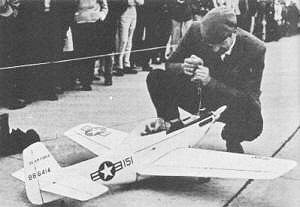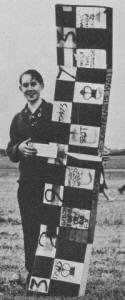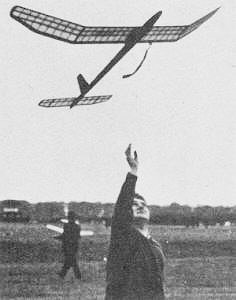This report of the 1962 (16th)
British Nationals appeared in the 1963 Annular edition of American Modeler
modeler, which I believe was published in January of 1963. Just as back in the day,
the U.S. Nationals were held on a military installation (U.S. Navy sponsorship),
the British Nats were held at
Barkston Heath R.A.F. station. Although technically it was an
international event, it appears that Brits and Yanks were the only competitors -
or at least the only ones mentioned. See anyone you know?British Nationals

Best Scale radio controlled flight performance was by Jack Morton
with his 2nd place Sterling Mustang. Super Tigre .51 power and Orbit R/C equipment.
Dull weather persisted throughout the two-day 1962 British Nationals meet at Barkston
Heath R.A.F. station. Windbreakers or thick pullover sweaters were the uniform of
the day for most. Despite the unwelcome conditions, some excellent performances
were turned in. There were twenty all-max scores in F/F gas and fourteen in rubber
while the C/L circles witnessed the highest-ever speed officially recorded in a
British contest.
There were seven free-flight contests, eleven control-line classes (including
five speed groupings), two R/C events. Radio consisted of "rudder-only"
i.e., rudder plus engine throttle) and scale. In this latter event, emphasis was
on scale accuracy, construction and finish. Highest overall score went to Dennis
Thumpston's superb Sopwith 1 1/2-Strutter with single-channel Wright radio gear
and Rivers Silver-Streak .15 diesel.
The most impressive flying was by Jack Morton with his F-51 Mustang, built from
a Sterling kit and using an Orbit 10-channel rig and Super-Tigre .51 power. He took
second followed by W. H. D. Lowe with an Orbit 2/10 equipped Hawker Hurricane original,
powered by a Super-Tigre .56. WW-II fighters were represented by a couple of Spitfires
and another Sterling Mustang, all with Orbit-10 R/C gear. One of the Spitfires,
entered by Geoff Franklin, was from George Harris's . design (which appeared
in American Modeler). It was fitted with a Super-Tigre 56 motor. The other Spit
was a K&B 45 powered original by D. Bryant; the second Mustang, by R. A. Norris,
had a McCoy 60. Trend in British 10-channel models is towards larger engines of
.49 to 60-cu-in dis-placement.

Fascinating entry in Multi R/C was Fokker D-8 by Barrister; it
employed Merco .35 powerplant.

Not an entry, but Ray Brown's Merco .35 "Coy-Lady"
is indicative of G.B. stunters. He was on '62 FAI team.

GB's Frank Warburton and USA's Jeep Newman 1st-2nd in
stunt. J. N. refuels so Frank can try USAF'ers job.

USAF's Major John Rice entered this T.D.-15 powered Ramrod
in free flight, cracked wing when D/T'ing on cement.

Sue Allsop flew her O.S. Max-II .15 entry against the boys in
the "open" free flight event. (Yes, it's "Miss".)

Excellent flying R/C 10-channel Hurricane "XRF" by
W. H. D. Lowe, 3rd in scale R/C.

Sterling Mustang by R. A. Norris used Orbit 10, McCoy 60; red-white-blue.

Fairchild PT-19 was modified Jetco Kit; G. Goldsmith; Orbit 10;
K&B 45.

Enya 60, 3rd-line throttle control on Bob Ivans' fine C/Line
Bristol Scout.
In place of multi at this year's Nationals and to provide a class for modelers
who cannot afford expensive multi equipment, the so-called "mono-control"
(Ripmax Trophy) event failed to achieve its purpose.

Big stunter by Dave Platt: Merco .49 mill; 12-6 Power Prop; 825
square in. wing area; she weighed 54 ounces.
Rules specified a single control surface plus engine throttle but did not place
any restriction on the type of equipment used to secure this. Instead of inexpensive
single-channel equipment and compound escapements, most of the top performances
carried multi-channel equipment for just rudder and engine ... a favorite set-up
being 4 channels off an Orbit 10, two for rudder and two for engine. One entry had
six channels with half-rudder positions! Against these, an escapement airplane did
not have much chance.

Brian Bow's gas powered tailless was cut-down remains of
earlier 12-foot span glider. Took 3rd in "no-tail" event for the Lady
Shelley Cup.
In U-control stunt the winner, as expected, was Frank Warburton. He has been
climbing steadily to the top during the past three years; earlier this year he had
topped other contenders for the British FAI stunt team. Frank used his latest scale-like
original, a Merco 35 powered Kawasaki "Tony," spanning 55" with a
560-sq-in wing and weighing 42-oz.
Second in stunt - only 25 points behind and 52 points ahead of the third man
- was an American entrant, "Jeep" Newman. He flew a very attractive and
well-finished Fox 35 powered model based on Bill Werwage's Aries.

Three year-old Sopwith 1 1/2-Strutter by Dennis Thumpston topped
R/C Scale.
The speed classes were marked by another notable American performance. Class
3 event for 5 to 10cc engined models was won by Maj. Gus Johnson, USAF, with a McCoy
60 powered ship at 166.9 mph. We believe this is the highest speed ever recorded
outside the USA with a piston engined model airplane. It will probably be recognized
as an official British all-comers' record. In the small classes, Pete Drewell,
No.2 man on the British speed team, at the World Championships, clocked 126.3 in
Class I (.15) and 123-mph in FAI .15 (straight fuel) using a Carter CCS motor. Johnny
Hall won the .30-cu-in class at 144.3-mph.

Driven by two O. S. engines, coaxial prop Fairey Gannet by Bruce
Randle was 1st, C/L scale.
Three classes of teamrace were run. In the newly instituted Half-A class (1.5cc
or .09-cu-in) there were 63 entries. Fastest time in the 5-mile eliminating heats
was 4:19 by Dick Place of the RAF Model Aircraft Association. D. Nixon won the 10-mile
final in 9:26.2. Nine fastest qualifiers were powered by Oliver Tiger Cubs turning
6x8 or 6x9 props.

"Women's Cup" (for T/L or rubber) was won by Mrs.
Stott with 3 maxes. Designed by her hubby, Geoff Stott.
The FAI class T/F final, slightly faster than last year, resulted m a win for
A. Wallace at 4:48 for the 10 kilometers. The B teamrace, not quite so fast as in '61,
was won in the rapid time of 6-min, 58.5-sec by R. Lucas. Lucas set the fastest
time of the day in the 5-mile eliminating heats With a fantastic 2:55 dash .. Using
isopropyl alcohol fuel he averaged nearly 103-mph non-stop.

Pretty R/C entry: Anderson's Cessna in Swiss markings;
1-chan; AM .21 diesel.
Scale events (other than R/C) offered the Super Scale Trophy for free-flight
models and the Knokke No.2 for control-line. John Simmance won the former event
for the second year running, Dr. M. F. Hawkins was runner-up. Bruce Randle topped
the control-line crowd with a new, improved model of his very remarkable 1960 Nats
entry ... a Royal Navy Fairey Gannet anti-submarine reconnaissance aircraft which
has twin turbo prop engines driving coaxial airscrews.

Impressive tailless rubber-powered job by John Pool won top honors.
Randle's 38" miniature duplicates this arrangement with an inverted
O.S. 35 driving the front prop through an extension shaft, while an O.S. 15 side-mounted
in front of the 35 drives the rear prop through spur gears!

Of 20 in F/F "fly-off" half were Dixielanders. George
Fuller, above, designed it; had T.D.-15 in his.
By tradition, free-flight events at the British Nats are "open" affairs,
by which is meant that they are mostly unrestricted as regards model design. The
reason for this is to simplify processing. As a result, ultra hot climbs are much
in evidence in both power and rubber and fly-offs are inevitable.
Fly-offs for the main F/F gas and rubber events, namely the Sir John Shelley
Cup and Model Aircraft Trophy contests, were scheduled for 6 PM on the second day.
As things turned out, the wind had, by this time, dropped to the gentlest of breezes
and timekeepers were obliged to watch the three top rubber jobs for more than ten
minutes apiece as they drifted slowly across the field. R. Lennox was the winner
with a time of 10:16.

A/2 towline glider by Yvonne Mosedale placed 2nd in ladies'
event; being released by Martyn Pressnell.
In the 20-model power fly-off almost everybody got into the air simultaneously.
We counted no less than 14 models circling close together at one time, but the eventual
two top men launched a little later and caught more lift for 5:48 and 4:44 respectively.
The event was won by John West, flying a Cox Tee-Dee 15 powered Dixielander design
by George Fuller. Second was Dave Posner with a light, 16-oz version of his FAI
Dream Weaver powered by a Cox 15 Special. 1955 World F/F Champion Mike Gaster, was
third, 30 seconds behind Posner.
In the glider event for the Thurston Cup, Geoff Dallimer topped the fly-off.
A special combined glider/rubber event for lady contestants only was won by Mrs.
Geoff Stott with an all-max score. She flew a rubber job designed by her husband.
Second was Yvonne Mosedale flying an A/2 glider. Another combined rubber/glider
event was the Lady Shelley Cup for tailless models. It was won by John Pool with
an impressive tailless rubber job ... D/T was provided by petal type drag flaps
at rear of fuselage. Tony Young won the payload event for the PAA Trophy.
In all, there were 54 prizewinners at this 16th British Nationals. There were
a lot of other deserving people who didn't get any prizes: the CD's, timers,
scorers and numerous other officials and helpers, without whom the British Nats,
like any other, couldn't have been run. Bless 'em all!
Posted August 26, 2024
(updated from original
post on 7/25/2012)
|


